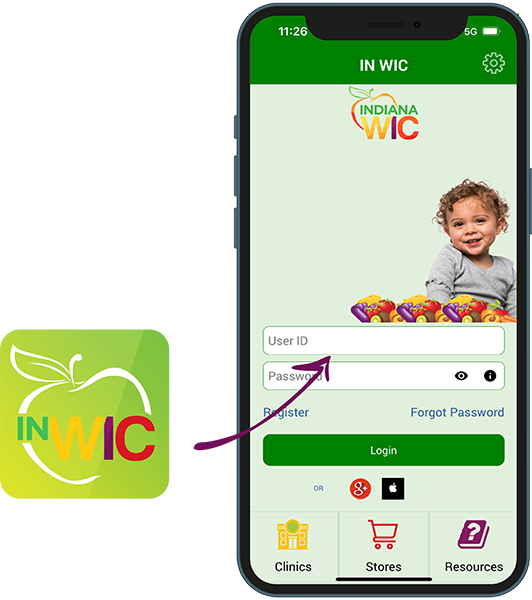What is WIC?
Who's Eligible?
- Pregnant women;
- Postpartum women (up to six months after delivery);
- Breastfeeding women (up to one year after delivery);
- Infants (babies under the age of one);
- Children under the age of five.

What Does WIC Provide?
- Nutrition and health screening and assessment
- Nutrition counseling and healthy food
- Breastfeeding education and support
- Health and social service referrals
How Does WIC Work?
Contact the WIC clinic in your community for a free visit to be enrolled and receive benefits. Clinic information can be found at wic.in.gov under WIC Clinic Locations List. Upon enrollment, your family will be eligible for all of the helpful services that WIC provides.
- Milk and milk products
- Yogurt
- Cheese
- Tofu
- Formula
- Baby food & cereal
- Cereal
- Fruits & Vegetables
- Whole Grains
- Juice
- Eggs
- Beans
- Peanut Butter
- Canned Fish
Why Use The INWIC App?
The INWIC App makes it easier to manage your benefits!


Income Eligibility
Families already receiving Medicaid, SNAP, or TANF are income eligible for the WIC program.
| Household* size | Annual income, up to $ (total before deductions) |
Monthly income, up to $ (total before deductions) |
Weekly income, up to $ (total before deductions) |
|---|---|---|---|
| 1 | $28,953 | $2,413 | $557 |
| 2 | $39,128 | $3,261 | $753 |
| 3 | $49,303 | $4,109 | $949 |
| 4 | $59,478 | $4,957 | $1,144 |
| 5 | $69,653 | $5,805 | $1,340 |
| 6 | $79,828 | $6,653 | $1,536 |
| 7 | $90,003 | $7,501 | $1,731 |
| 8 | $100,178 | $8,349 | $1,927 |
If you are pregnant, you may count yourself as two (2).
For households with more than 8 members, add $10,175 annual income for each additional member.
*Household means a group of people (related or not) who are living as one economic unit.
For more information or to find a clinic near you, email inwic@health.in.gov, call 800-522-0874, or visit our website at wic.in.gov.